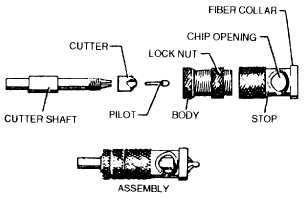Skin Fasteners
There are several types of skin fasteners used to
temporarily secure parts in position for drilling and
riveting and to prevent slipping and creeping of the
parts. C-clamps, machine screws, and Cleco
fasteners are frequently used for this purpose. See
figure 13-6. Cleco fasteners come in sizes ranging
from 1/1 6 to 3/8 of an inch. The size is normally
stamped on the fastener, but may also be recognized
by the following color code:
1/16 inch—black
3/32 inch-cadmium
1/8 inch-copper
5/32 inch—black
3/16 inch—brass
1/4 inch—green
3/8 inch—red
The Cleco fastener is installed by compressing the
spring with Cleco pliers (forceps). With the spring
compressed, the pin of the Cleco is inserted in the
drilled hole. The compressed spring is then released,
allowing spring tension on the pin of the Cleco to
draw the materials together. Clecos should be stored
on a U-channel plate to protect the pins of the Cleco.
Storing Clecos at random among heavy tools will
result in bent pins.
Machine Countersink
Machine countersinking is used to flush rivet
sheets 0.064 of an inch and greater in thickness. A
countersink has a cutting face beveled to the angle of
the rivet head, and is kept centered by a pilot shaft
inserted in the rivet hole. When a conventional
countersink is used, you should try each hole with a
rivet or screw to ensure the hole has not been
countersunk too deeply. The adjustable countersink is
the best tool to use because the depth of the hole can
be controlled. A stopping device automatically acts as
a depth gauge so that the hole will not be countersunk
too deep. Figure 13-7 shows an adjustable stop
countersink.
The countersink should always be equipped with
a fiber collar to prevent marring of the metal surface.
A drill motor or hand drill (electric or air) maybe used
to operate the countersink. However, it should not be
operated above 2,500 rpm. The countersink must be
sharp to avoid vibration and chatter.
Figure 13-6.—Skin fasteners.
Figure 13-7.—Adjustable stop countersink.
13-4



